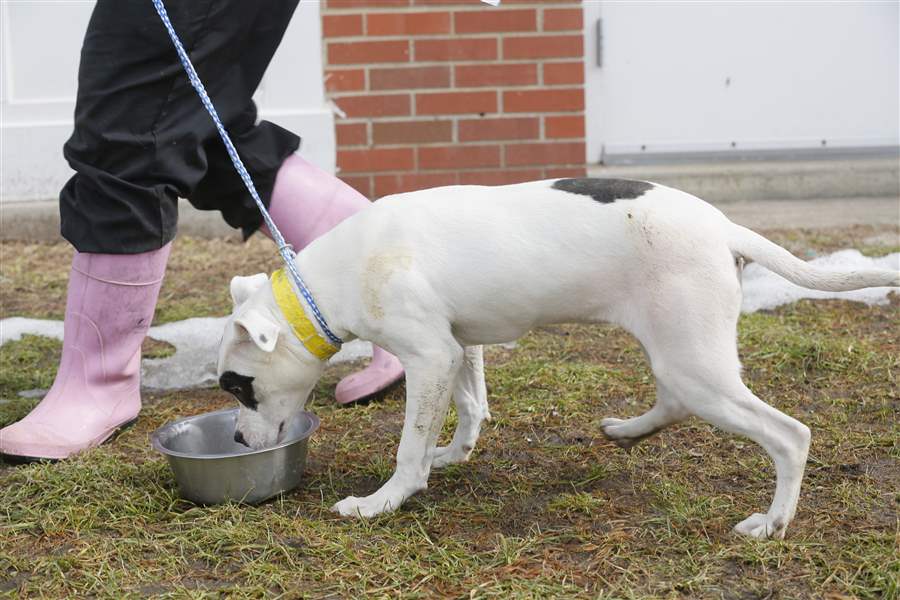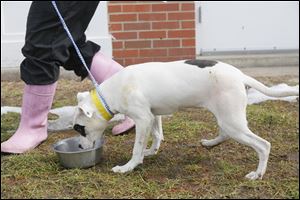
More food guarders killed than saved
Lucas County’s free-feeding program for dogs draws criticism
4/28/2014
Bella, a female "pit bull"-mix, eats out of her bowl outside of the Lucas County Canine Care & Control in March. Bella was part of a 60-day pilot program at Lucas County Canine Care & Control to cut down on the killing of food-guarding dogs.
The Blade
Buy This Image

Bella, a female "pit bull"-mix, eats out of her bowl outside of the Lucas County Canine Care & Control in March. Bella was part of a 60-day pilot program at Lucas County Canine Care & Control to cut down on the killing of food-guarding dogs.
With less than a week remaining, a 60-day pilot program at Lucas County Canine Care & Control to cut down on the killing of food-guarding dogs has resulted in more dogs killed than saved.

Lyle
“We have mixed results at this point,” shelter Director Julie Lyle said.
“We’re going to finish it out and see what we’ve got,” she said.
The program that began March 5 provides constant access to food, a technique called free-feeding, for dogs that freeze or growl over a food bowl but who do well in all other areas of their behavior evaluations.
“Pit bull”- type dogs that show concerning signs such as eating faster, having a stiff body, or refusing to lift their heads from the bowl during the test also are included in the program.
Previously, dogs of any breed that froze, growled, or bit over a food bowl and “pit bulls” with concerning behavior were killed instead of being made available for transfer or adoption.
In 2013, more than 200 dogs were killed because they did poorly on the food-guarding assessment.
Not all food guarders are accepted into the pilot program. Dogs that try to bite a fake hand, which is used during the assessment to pull a food bowl away and push the dog’s head out of the bowl while it is eating, are killed instead of being allowed in the program.
After the initial evaluation, dogs in the pilot program are offered to rescues while they are free-fed for a week before being reassessed. If the dog improves, it gets a second week in the program to find a transfer before it is killed. If it does not improve or gets worse, the dog is killed without a second week of free-feeding.
As of Friday, 20 dogs have been through the free-feeding program. Of those, three were transferred to dog rescue groups — one improved after a week and two were transferred before they would have been reassessed.
The Toledo Area Humane Society successfully adopted out a male cocker spaniel it transferred from the program. Planned Pethood reports a female beagle it took in is doing well in a foster home. The Lucas County Pit Crew reports the “pit bull” it accepted is being worked with for other behavior issues but shows no signs of food aggression.
“She has some challenges, but she’s not food aggressive, I can tell you that,” said Jean Keating, executive director of the Pit Crew. “She eats very nicely and is very gentle with treats.”
Five canines are in their first week of the program and are being offered for transfer, while another that improved after the first week is also waiting for a rescue.
“We’ve saved some dogs and that’s a positive thing,” said Carol Contrada, president of the Lucas County Board of Commissioners, which approved the trial.
But more than half of the dogs in the free-feeding program — 11 — were killed.

Contrada
One that had gone for behavior-modification training with the Prisoners Helping Dogs program at Toledo Correctional Institution bit his inmate trainer over a toy and was killed.
Another dog bit a shelter employee during the first week of the free-feeding program and was killed.
Of the nine other dogs killed, three did worse on their second evaluation and four others showed no improvement. One became aggressive toward people during the program and growled and lunged at workers.
The final dog’s food-guarding behavior did improve, but no rescues agreed to take it after a total of 20 days on the transfer list, so it also was killed.
Ms. Lyle said she has not formed an opinion about results of the free-feeding program thus far.
“I didn’t really have any expectations because it’s not data we’ve collected before,” she said, adding that the shelter has been in contact with the American Society for the Prevention of Cruelty to Animals about the program.
None of the dogs in the program is offered for adoption at the county shelter, even if the free-feeding program is successful. They must be accepted by a rescue group and transferred or they will be killed, even if they show improvement.
Ms. Lyle said once the county shelter sees potential aggression in a dog, it cannot be adopted from there out of a concern for public safety.
With the restrictions that Ms. Lyle has placed on the pilot program, which was recommended by Mrs. Contrada, it would seem Ms. Lyle has accepted that many of the dogs in her care must be killed. At every turn she has a reason why she must kill dogs at the county shelter, but her usual fall-back position is “public safety.”
When asked why a dog whose food guarding behavior has been changed can’t be adopted to the public, she replied: “We still saw that initial behavior.”
But if the dog is no longer a food guarder?
“Just because they did well on a different day, doesn’t mean we didn’t see the aggression. Our primary purpose is public safety. We are not going to compromise that.”
Why a week?
And why does Ms. Lyle give a food-guarding dog in the pilot program only a week to improve before it is killed?
“We’re not going to hold a dog indefinitely that has shown us potential for aggression,” Ms. Lyle said. “If they don’t improve or get worse, that is a dog that has a decent potential for aggression. We’re not going to continue to use resources on a potentially aggressive dog when there are others who haven’t shown us any of that behavior.”
Ms. Keating said there is no existing research on programs like the county shelter’s pilot free-feeding program that would help determine appropriate guidelines to follow, but a time frame needs to be established.
“To put a time limit [of a week] on it is just people making educated guesses about what they can and can’t do based on the resources they have,” she said.
Not simple

Keating
The cause of food-guarding behavior, she added, isn’t always simple and can’t always be addressed entirely through free-feeding.
“Some dogs that food guard are just dogs that are hungry, and they come around and are fine,” Ms. Keating said. “Other dogs have more problems than that. They require more specific intervention and handling, and you really can’t provide that in a pound environment.”
Emily Weiss, the ASPCA senior director of research and development, said free-feeding helps dogs in the majority of cases, sometimes within just a couple days. She said community involvement is crucial in the success of any rehabilitation program because behavior modification is most successful in home environments.
“It’s important to note that it takes partnerships with other area shelters and rescue groups, animal welfare professionals, and passionate animal advocates in order to give these dogs the best chance possible for rehabilitation,” she said.
So why doesn’t Lucas County Canine Care & Control have a foster program for its dogs? Again, Ms. Lyle said that is both a liability issue for the county and a matter of limited resources. If the county established a foster program, Ms. Lyle said it also would be competing with area rescues for the same limited pool of available foster homes.
“We’re not against fostering, but there’s already a system out there that’s working with other groups,” she said.
“We try to get [county dogs] into that system that already exists.”
Ms. Lyle is trying to get area dog-rescue groups to agree to take former food-guarding dogs by waiving the usual $50 transfer fee, and rescues are offered an additional $100 incentive for each dog they take from the pilot program to help pay for the dog’s continued free feeding.
Mrs. Contrada said through the free-feeding program, the county has strengthened its relationships with its more than 50 transfer partners and will continue to work with them on the issue of food guarding.
“We want to take a look at the data and have a thorough review with our transfer partners and other groups we engage with to get their perspective on dogs they have considered and accepted, and those they considered and rejected, and what their interest was in the program,” she said.
Against killings

Hood
Two of Mrs. Contrada’s political opponents in this year’s election — Democrat Michael Hood and Republican Kevin Haddad — said a week is not enough time for a dog in a high-stress environment with limited enrichment opportunities to change its behavior.
“I know dogs are coming in all the time, and I know it’s a challenge to place them, but I still don’t think a week is enough time,” Mr. Hood said. “They say it takes three weeks for a person to change a habit. And when people go in for drug treatment, it’s usually 30 days. ... I think 21 to 30 days [of free-feeding] would be reasonable.”
Mr. Hood and Mr. Haddad also said the county’s potential liability in setting up a foster program can be mitigated with signed written agreements with foster families. Mr. Haddad said if rescue organizations can have successful foster programs, the county shelter should be able to as well.
‘A last resort’
“You can at least give it a shot,” Mr. Haddad said. “Euthanizing an animal should be the last resort. If it’s a volunteer program then it shouldn’t cost much. Why not try it?”
A second Republican candidate for commissioner, Ben Roberts, said the county has an obligation to try every possible avenue before killing a dog.
“Killing a defenseless animal that hasn’t had a fair shake to start with doesn’t make sense,” he said. “If there’s a problem, then we need to come up with new and creative solutions.”
Mrs. Contrada said the shelter will not stop free-feeding at the end of the 60-day period, though the long-term future of the program has yet to be decided.
“Once the 60-day time frame has expired, we will continue the program while we review,” she said.
“We need to understand these results, and if we have to do a deeper data dive with a longer [data] collection period, then we will. ... We’re really taking a very in-depth look at how free-feeding works within a public shelter setting.”
Ms. Weiss said such review is critical to ensure maximum benefit for the animals.
“Collecting and analyzing data and trends is extremely important for animal shelters because it helps them to monitor and adjust programs to maximize effectiveness,” she said.
She added that the demand placed on animal-control facilities is high and resources are often limited.
“Most municipal animal service facilities across the country are built as short-term housing,” she said.
“They typically have limited animal-care staff, limited funding, and a host of daily responsibilities including feeding, cleaning, and enrichment.”
When asked for suggestions of possible ways the Lucas County shelter’s program could be improved, the ASPCA official again stressed community involvement.
“The task of changing the outcomes for these dogs is a communitywide effort and should not rest on the shoulders of one agency,” Ms. Weiss said.
“If the community were to pitch in and help raise both funds and awareness for the implementation of more support programs to help the local shelters, they will save more animals.”
Ms. Keating echoed Ms. Weiss, saying she believes that area rescues that regularly bring in dogs from outside the region or the state are contributing to the local problem.
While dogs are still being saved, those outside dogs are taking up spots for Lucas County dogs in similar situations and compounding the local problem.
“This is a problem in our community; it’s not a problem at the Lucas County Canine Care & Control facility,” she said. “If we want to make a difference, then the resources in our community have to step up to the plate and take these dogs in and work with them. I don’t see that happening. In order to solve this, we have to all work together in the same direction, and that’s not happening.”
She added that the county shelter almost always has dogs that have not shown any signs of potential aggression but still have been in the shelter for weeks, sometimes months, waiting for a family or a transfer.
“It’s not a good situation when there are so many really nice dogs waiting for a home, and you’ve got limited resources,” Ms. Keating said.
“In a perfect world we could save them all, but it’s not a perfect world.”
Contact Alexandra Mester: amester@theblade.com, 419-724-6066, or on Twitter @AlexMesterBlade.